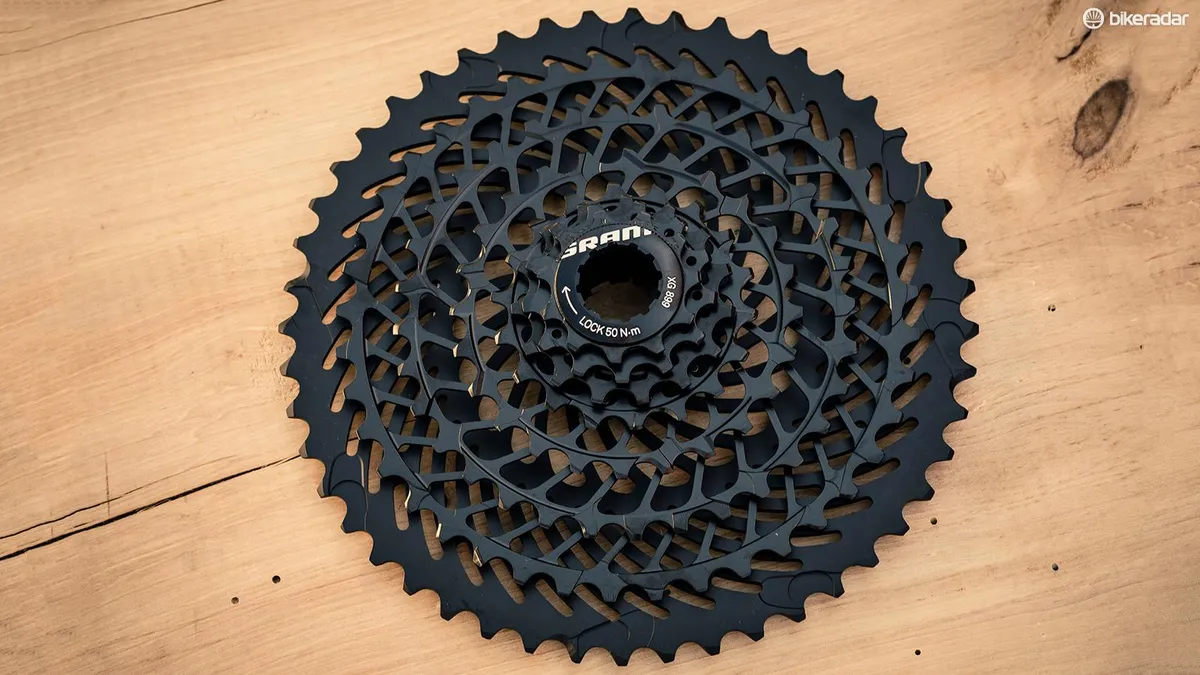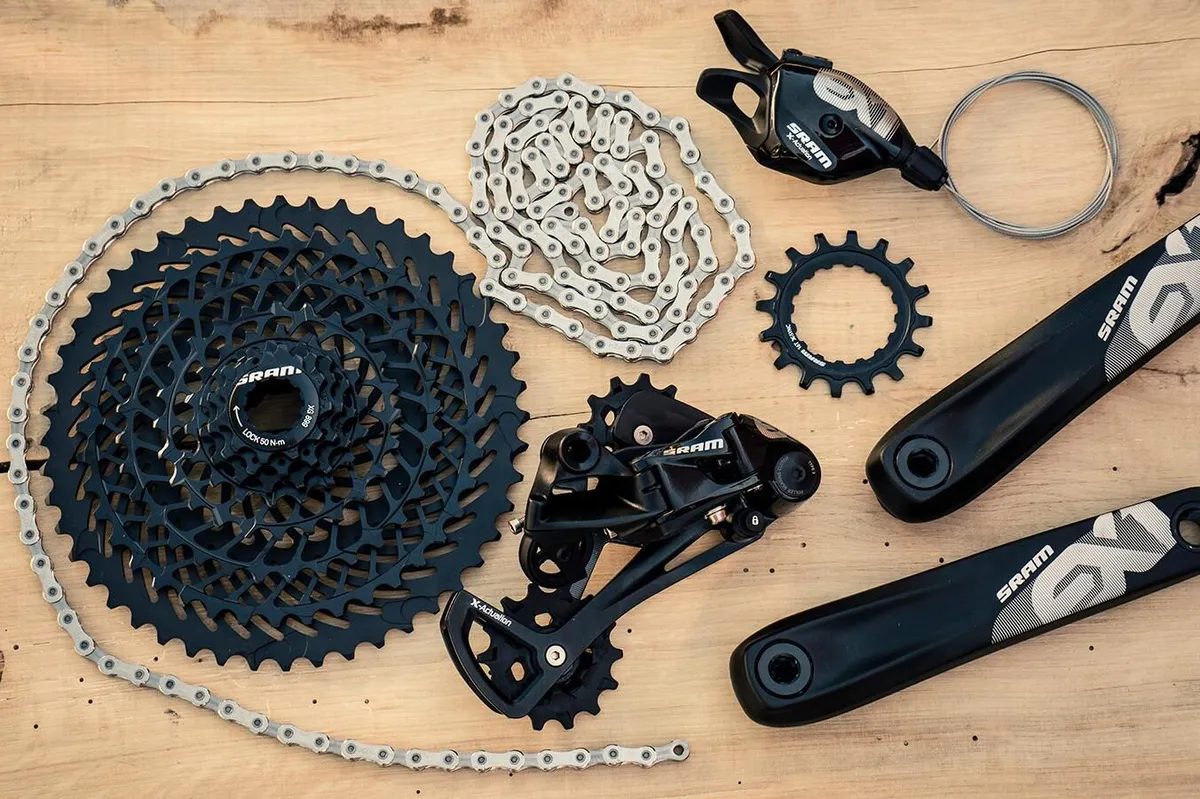Love them or hate them, e-bikes – or more specifically in this case, e-mountain bikes – are here to stay. Though their popularity seems to really fluctuate from country to country, there’s no getting away from the fact that manufacturers are selling more of them, no matter where you are in the world.
Though, for the most part at least, the current crop e-mountain bikes use standard mountain bike parts, SRAM, having spoken to many of their customers who have e-bikes in their stable, knew there were issues that needed addressing – particularly when it came to shifting.
The brand has responded with a new e-MTB-specific drivetrain, named EX1. That's joined by a dedicated line of brakes – Guide RE.
The new e-mtb specific drivetrain from sram: ex1 & guide re brakes
Breaking chains
"Most of our customers gave us a hard time saying, 'Hey, we need a super strong chain, as we always have problems with [that], so we discussed this with our engineers and it seems the chain is not the main issue. The main issue that all the drivetrain are specially designed for normal riders”, said Marcus Schneider, E-MTB product manager at SRAM.
"We have this little fellow [the Bosch motor] here in the e-mountain bike, and he has a completely different way to bring torque and power into the drivetrain," Schneider added.

A new 8spd 11-48t cassette, the E-Block, is designed to allow riders to shift accurately under power
After months of data acquisition and numerous broken chains, SRAM’s senior advanced development engineer, Henrik Braedt discovered that the maximum loads were not in fact the main issue. The biggest challenge for the drivetrain was more to do with the different way in which the bike is used.
"Because of the acceleration you shift far quicker, you do double shifts and cross-chaining affects the whole system," Braedt explained.
SRAM wanted to be able to reduce the loads on the chain as well as address the issues brought about by cross-chaining and the stress and wear this can put on the entire system.
Cassette cunning
SRAM is no stranger to doing things a little differently when it comes to cassettes. The EX1 cassette, ‘E-Block’ as it’s known, uses just eight cogs 11-48t (allowing for a 436% gear range) and, unlike most of SRAM’s other top end offerings, uses a standard, not XD, driver body. Braedt wanted a huge cassette, with a massive biggest cog because, he said, this is one factor that "helps to reduce the chain load".
To reduce cross-chaining, the position of the biggest cog is 7mm inwards compared with an 11-speed drivetrain, Braedt said.

Using a spacer behind the cassette shifts its position and helps avoid cross-chaining
While the three smallest cogs are pretty standard and easily interchangeable should you wish to alter your harder gears, it’s the bigger, five fixed sprockets where a lot of the work has been put in with a focus put on shifting control.
Those larger five cogs are all evenly numbered (18, 24, 32, 40, 48t) and offer big (on average, 30%) steps between the gears – which are necessary because of the fast acceleration that comes courtesy of strapping a motor to your bike. Key to the E-Block is the ‘defined link position’. By syncing the chain with specific teeth on the cog – much like SRAM’s X-Sync chainrings do – the shifter ramps can be designed to work specifically with the inner link or outer link of the chain, while shifter ramps on a standard cassette have to work with both. All of this helps reduce stress on the drivetrain when shifting, even under full load.

The five biggest cogs are deisgned to work specifically with the chain's inner or outer links
But what if the chain is in the wrong position on the cog? Thanks to a ‘correction tooth’, the chain will soon be repositioned where it needs to be.
One-shift wonder
Punching your shifter hard when fully on the gas and hammering through multiple gears by double shifting puts huge amounts of stress on the drivetrain, so add a motor into the equation and this becomes a real problem.

The eight-speed 11-48t cassette uses big gear steps to compensate for the e-bike motor's acceleration
But with the e-bike and a standard cassette, you need to shift more frequently and faster due to the rapid acceleration. With the bigger gear steps courtesy of the new E-Block, SRAM decided it was better to go with a single shift at a time, which the brand claims improves shifting accuracy and helps to increase battery life as well as reducing wear on components. Again, according to the SRAM guys point out, it’s all about control, especially under these high loads.
Keeping it cohesive
While the main focus rests on the EX1 cassette, let’s not forget the other pieces of the puzzle here. The new E-Crank is designed to work with likes of Bosch and Brose mid-ship motors and available in 170 or 175mm crank lengths.
Keeping in sync (get it?) with its other 1x transmissions, SRAM’s EX1 drivetrain uses an X-Sync chainring, which features an alternating tooth pattering to perfectly sync with the chain for improved security. There are 14, 16 and 18t chainrings available for Bosch motors and a 34t ring for the Brose motor.

SRAM's EX1 E-Crank is designed to work specifically with Bosch and Brose mid-ship motors
At the rear sits the EX1 X-Horizon rear derailleur. This harnesses all of the technology SRAM's other standard 1x drivetrains use, including X-Sync jockey wheels, the X-Horizon straight parallelogram and Cage Lock, which makes life that bit easier when removing your rear wheel. SRAM say the EX1 rear derailleur has been purpose built to withstand the trials of life aboard an e-mountain bike.
And let’s not forget the chain. The EX1 chain is wider and stronger in a bid to handle the high torque loads and is designed to work with the new 8spd cassette. It still gets SRAM’s PowerLock link, making it easy to take on and off the bike.
All pricing was TBC as this article went to press; we'll add more when we have it.
Brake down
Aside from the new drivetrain, SRAM has also put some thought into slowing e-mountain bikes down. They are after all hefty beasts to say the least, and need a decent amount of power to scrub off speed confidently. SRAM’s answer to this is the Guide RE brake.

The Guide RE brake is identical to the Guide DH seen on some Specialized DH bikes
Those with a keen eye will have spotted something similar in use on the production Specialized Demo downhill bikes, badged up as the Guide DH brake. Just like the DH, the RE mates a Guide R lever to a four-piston Code caliper. While the Guide R offers up tool-free reach adjust, SRAM has opted to use a sintered pad in the big four pot caliper to improve pad life.
• Pricing: £112 / US$133 / €145 per end
Initial impressions
Having not spent a great deal of time aboard e-MTBs, and not having an e-MTB with a standard drivetrain on in Finale to directly compare EX1 with, does obviously make drawing any conclusions for just a couple of days riding pretty difficult. That said, I did notice a couple of things while riding EX1.
First off, and just as promised, I was surprised just how recklessly I could shift without letting up on the power. Punching through the gears while out of the saddle, hammering uphill didn’t seem to faze the shifting, no matter how ham fisted I was or how inappropriately timed the shifts were.

Going uphill, we constantly found ourselves shifting under power with zero issues
Another thing I noticed was when the chain didn’t properly sync with the cassette teeth. This calls the correction tooth into play which skips the chain into the correct position on the cog. The one and only time this happened (or at least, the only time I noticed it), yes, I did feel it but it had no real effect on the performance.
Once we get EX1 on an e-MTB for ourselves and put it up against another with a standard drivetrain, while give you more insight into exactly how it differs in terms of feel and find out just how well it holds up over time.








